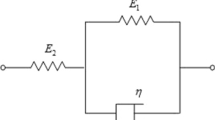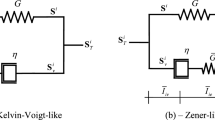Abstract
The correspondence principle is an important mathematical technique to compute the non-ageing linear viscoelastic problem as it allows to take advantage of the computational methods originally developed for the elastic case. However, the correspondence principle becomes invalid when the materials exhibit ageing. To deal with this problem, a second-order two-scale (SOTS) computational method in the time domain is presented to predict the ageing linear viscoelastic performance of composite materials with a periodic structure. First, in the time domain, the SOTS formulation for calculating the effective relaxation modulus and displacement approximate solutions of the ageing viscoelastic problem is formally derived. Error estimates of the displacement approximate solutions for SOTS method are then given. Numerical results obtained by the SOTS method are shown and compared with those by the finite element method in a very fine mesh. Both the analytical and numerical results show that the SOTS computational method is feasible and efficient to predict the ageing linear viscoelastic performance of composite materials with a periodic structure.
Similar content being viewed by others

References
Nguyen Viet, H., Pastor, J., and Muller, D. A method for predicting linear viscoelastic mechanical behavior of composites, a comparison with other methods and experimental validation. European Journal of Mechanics A-Solids, 14(6), 939–960 (1995)
Yi, Y. M., Park, S. H., and Youn, S. K. Asymptotic homogenization of viscoelastic composites with periodic microstructures. International Journal of Solids and Structures, 35(17), 2039–2055 (1998)
Liu, S. T., Chen, K. Z., and Feng, X. A. Prediction of viscoelastic property of layered materials. International Journal of Solids and Structures, 41(13), 3675–3688 (2004)
Lahellec, N. and Suquet, P. Effective behavior of linear viscoelastic composites: a time integration approach. International Journal of Solids and Structures, 44(2), 507–529 (2007)
Ricaud, J. M. and Masson, R. Effective properties of linear viscoelastic heterogeneous media: internal variables formulation and extension to ageing behaviours. International Journal of Solids and Structures, 46(7-8), 1599–1606 (2009)
Vu, Q. H., Brenner, R., Castelnau, O., and Moulinec, H. Effective behaviour of viscoelastic polycrystals and associated local fields inferred from homogenization: incremental collocation approach. Procedia Engineering, 10, 177–182 (2011)
Nguyen, S. T., Dormieux, L., Le Pape, Y., and Sanahuja, J. Crack propagation in viscoelastic structures: theoretical and numerical analysis. Computational Materials Science, 50(1), 83–91 (2010)
Masson, R., Brenner, R., and Castelnau, O. Incremental homogenization approach for ageing viscoelastic polycrystals. Comptes Rendus Mcanique, 340(4-5), 378–386 (2012)
Sanahuja, J. Effective behaviour of ageing linear viscoelastic composites: homogenization approach. International Journal of Solids and Structures, 50(19), 2846–2856 (2013)
Bensoussan, A., Lions, J. L., and Papanicolaou, G. Asymptotic Analysis for Periodic Structures, North Holland, Amsterdam, 158–179 (1978)
Mori, T. and Tanaka, K. Average stress in matrix and average elastic energy of materials with misfitting inclusion. Acta Metallurgica, 21(5), 571–574 (1973)
Hill, R. A self-consistent mechanics of composite materials. Journal of the Mechanics and Physics of Solids, 13(4), 213–222 (1965)
Li, Y. Y. and Cui, J. Z. The multi-scale computational method for mechanics parameters of the materials with random distribution of multi-scale grains. Composites Science and Technology, 65(9), 1447–1458 (2005)
Han, F., Cui, J. Z., and Yu, Y. The statistical second-order two-scale method for mechanical properties of statistically inhomogeneous materials. International Journal for Numerical Methods in Engineering, 84(8), 972–988 (2010)
Yang, Z. H., Cui, J. Z., and Nie, Y. F. Microstructural modeling and second-order two-scale computation for mechanical properties of 3D 4-directional braided composites. CMC-Computers, Materials and Continua, 38(3), 175–194 (2013)
Yang, Z. Q., Cui, J. Z., and Ma, Q. The second-order two-scale computation for integrated heat transfer problem with conduction, convection and radiation in periodic porous materials. Discrete and Continuous Dynamical Systems-Series B, 19(3), 827–848 (2014)
Yang, Z. Q., Cui, J. Z., and Nie, Y. F. The second-order two-scale method for heat transfer performances of periodic porous materials with interior surface radiation. CMES-Computer Modeling in Engineering and Sciences, 88(5), 419–442 (2012)
Cioranescu, D. and Donato, P. An Introduction to Homogenization, Oxford University Press, New York, 125–137 (1999)
Cui, J. Z., Shih, T. M., and Wang, Y. L. The two-scale analysis method for bodies with small periodic configurations. Structural Engineering and Mechanics, 7(6), 601–614 (1999)
Yu, Y., Cui, J. Z., and Han, F. An effective computer generation method for the composites with random distribution of large numbers of heterogeneous grains. Composites Science and Technology, 68(12), 2543–2550 (2008)
Author information
Authors and Affiliations
Corresponding author
Additional information
Project supported by the National Natural Science Foundation of China (No. 11471262)
Rights and permissions
About this article
Cite this article
Zhang, Y., Cui, J. & Nie, Y. Second-order two-scale computational method for ageing linear viscoelastic problem in composite materials with periodic structure. Appl. Math. Mech.-Engl. Ed. 37, 253–264 (2016). https://doi.org/10.1007/s10483-016-2029-8
Received:
Revised:
Published:
Issue Date:
DOI: https://doi.org/10.1007/s10483-016-2029-8



